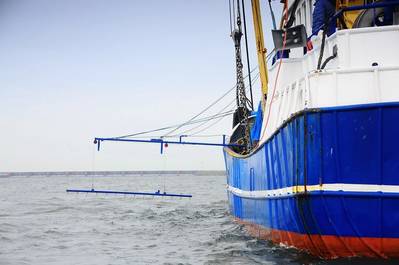Nonlethal Equipment Prevents Robbery at Sea
Multilayered approach deters criminals and prevents unwanted boarding
Westmark BV has recently performed a test in which passive nonlethal equipment served in a multilayered strategy to protect fishing crews from the threat of robbery at sea. Until now fishing vessels operating in high risk areas have been virtually unprotected. Due to low freeboard, low speed, these vessels are a vulnerable target for heavily armed criminals. Employing armed guards is not an option for these fishing boats.
During a recent experiment in Dutch waters (Haringvliet) Westmark equipped a fishing vessel with a multilayered strategy to protect the vessel using two barriers of passive non-lethal equipment against sea criminals.
Pirate Trap
One barrier that took the test is the P-Trap antipiracy system, the other barrier involved a sound cannon used in an innovative way. The successful trial showed that the operation of fishing gear is not affected by the safety spread of trailing lines connected to the P-Trap. Prior to this test the system has served on board the fishing vessel for an entire week, in which it was put to the test during heavy storms on the North Sea.
The P-Trap system is operated alongside the vessel with a safety spread of multiple protective lines in the water on both sides of the vessel. The propeller of a hostile vessel within boarding range entangled in the lines during their attack. Its engine will stall as a result of this, and the intruder will not be able to continue its attack, meaning that pirates cannot climb aboard.
Sound cannon
A sound cannon test also demonstrated the usefulness of having multiple barriers to prevent unwanted boarding. The patented penetrating sound tones discourage intruders from coming too close to the vessel. The powerful sound is so irritating and potentially damaging that it discourages the attacking vessel in its approach.
Combination of technical barriers
Piracy and maritime crime is not only a problem in the East or West Africa. There are several hot spots in the world that deal with these criminals activities. Passive nonlethal antipiracy solutions form the basis of protection and can be operated in conjunction with other equipment seafarer’s use in their daily operations on board. Crews of small vessels need protection and their functionality depends on the safe overall movement of freight by ships.
The combination of legal techniques, such as P-Trap and sound cannons, is currently being tested on vessels in the Gulf of Guinea, where maritime criminal activity has intensified in recent years. These sustainable protection solutions will serve as a basis for owners of fishing fleets to protect the safety of their seafarers, while allowing fishing in this area in an economically viable way, and setting the stage for testing several barriers to prevent unwanted boarding.
Dutch marine specialist Westmark developed the P -Trap anti-boarding solution and has installed systems on multiple vessel types (e.g. dredging, transport, heavy cargo vessels, as well as chemical tankers and small coasters). With the successful test of a multilayered strategy on board small fishing vessels the company proves that its solutions can be used for protecting every vessel, irrespective of its functionality and size.
ptrap.com












